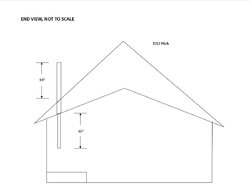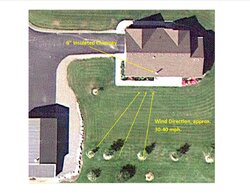Any topographical concerns? Mountains, ridges, hills? Is it only when the wind is from the direction indicated? Might look kinda silly, but I'd try getting over the peak.
I get the exact opposite in a strong wind.
No topographical issues, this home is located on a prairie of sorts. According to the homeowner, the issue is directly related to the wind direction and velocity as shown on the diagram. As mentioned in the original post, a 48" extension had put the cap basically even with the peak of the roof. Though not over the peak, I am very surprised that this did not fix the problem.
wind directional cap (use your extra 48" if it there and set up already), im with jeff on this one and i dont like seeing the cap so far below the roof peak (wind firing off that opposite side prolly tails right down your stack).
My next move was to re-add the 48" extension along with the wind directional cap, if no other suggestions were made that seemed likely.
Jason, You are ignoring the number one rule - min 3 ft above highest peak with in a 10ft radius for the flue. This is only a rough guide number. In your diagram you are below the main peak. Until you extend the flue above the main peak your customer will continue to have difficulties. To accomplish this the flue may need external bracing, nature of the beast. It may take more than 3ft. above the main roof line. You are dealing with air currents caused by the roof lines. You need to get above that.
Not to disagree necessarily, but the peak of the roof is about 15' away. As installed, it meets all applicable requirements, such as 2' above any part of the roof within a 10' radius -and- a minimum exit of 3'. I know that these are safety codes and don't ensure proper draft and the rule you may be speaking of is more of a draft related rule of thumb. We have installed hundreds of chimneys where the cap did not clear the peak of the roof (where the peak is beyond the 10' radius), and never once had a problem like this, not once. As the flue already stands 94", an external brace is already installed so that isn't a big hurdle. Are you thinking that getting the flue over the peak would eliminate the need for a wind cap?
Ditto. With 7/12 pitch, you need 10' * 7/12 + 3' = 108 inches exposure.
I'm pretty sure that the rule is 2' over any point within the 10' radius and minimum exit of 3', and remember, a 48" extension has already been tried which put the total height well over the rule whether it's 2' or 3', thanks for your input.
these guys are right, i guess if wind always blew in one direction 100% of the time and wind never tailed of a rooftop (like mountain tops) which it does, it would be alot less worrisome. here is a pic of wind off a mountain and you can see why its so important get that cap up over the level of wind whipping off the peak (maybe you can be equal to peak because your stack is pretty far away from it in this case) but i think that needs to be your first step.
I'm guessing the wind in that picture is coming from the right. If so, then I would expect a huge problem if the chimney was on the left side and lower than the peak. With the chimney on the same side that the wind comes from (see the diagram again), the wind would have to be curling back around to hit the chimney top. I did already try a 48" extension that placed the top of the chimney even with the peak. I have considered re-adding the 48" pipe along with a wind directional cap. In my mind, I see a lot of turbulence near the chimney that would only confuse a wind directional cap on which way to turn. Thanks for your input.
Thanks, everyone for your input. I'm not trying to be argumentative here, just looking to make sure you're all aware of the steps that have already been tried. From everyone's input, I gather that going back to even with the peak and using a wind cap may solve the problem, or adding even more length to clear the peak (this would then be 6 feet over the 2/10 rule).
Many thanks,
Jason






